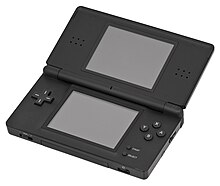
Back قائمة أكثر أنظمة ألعاب الفيديو مبيعا Arabic Liste der meistverkauften Spielkonsolen German Anexo:Consolas de videojuegos más vendidas Spanish فهرست پرفروشترین کنسولهای بازی Persian Luettelo parhaiten myyneistä pelikonsoleista Finnish Liste des consoles de jeux vidéo les plus vendues French Daftar konsol permainan terlaris ID 家庭用ゲーム機の販売台数一覧 Japanese ყველაზე გაყიდვადი ვიდეო თამაშების კონსოლების სია Georgian Lista de consoles de jogos eletrônicos mais vendidos Portuguese

A home video game console is a standardized computing device tailored for video gaming that requires a computer monitor or television set as an output.[2] Video game consoles usually[2] weigh between 2 and 9 pounds (1–4 kg) on average,[3] and their compact size allows them to be easily used in a variety of locations, making them portable.[3] Handheld controllers are commonly used as input devices. Video game consoles may use one or more data storage devices, such as hard disk drives, optical discs, and memory cards for downloaded content.[3] Dedicated consoles are a subset of game consoles that are only able to play built-in games.[4][5] Video game consoles in general are also described as "dedicated" in distinction from the more versatile personal computer and other consumer electronics.[6][7][8] Sanders Associates engineer Ralph H. Baer along with company employees Bill Harrison and Bill Rusch licensed their television gaming technology to contemporary major TV manufacturer Magnavox. This resulted in the 1972 release of the Magnavox Odyssey—the first commercially available video game console.[9]

A handheld game console is a lightweight device with a built-in screen, controls, speakers,[11] and has greater portability than a standard video game console.[3] It is capable of playing multiple games unlike tabletop and handheld electronic game devices. Tabletop and handheld electronic game devices of the 1970s and early 1980s are the precursors of handheld game consoles.[12] Mattel introduced the first handheld electronic game with the 1977 release of Auto Race.[13] Later, several companies—including Coleco and Milton Bradley—made their own single-game, lightweight tabletop or handheld electronic game devices.[14] The oldest handheld game console with interchangeable cartridges is the Milton Bradley Microvision from 1979.[15] Nintendo is credited with popularizing the handheld console concept with the Game Boy's release in 1989[12] and continued to dominate the handheld console market into the early 2000s.[16][17]
- ^ Cite error: The named reference
best ps2was invoked but never defined (see the help page). - ^ a b Lee, Robin (August 23, 2012). Peitz, Martin; Waldfogel, Joel (eds.). The Oxford Handbook of the Digital Economy. Oxford University Press. p. 84. ISBN 9780195397840. Archived from the original on October 30, 2019. Retrieved December 29, 2013.
- ^ a b c d Shelly, Gary; Misty, Vermaat (February 25, 2010). Discovering Computers 2011: Living in a Digital World, Complete. Shelly Cashman. Contributing authors: Quasney, Jeffrey; Sebok, Susan; Freund, Steven. Cengage Learning. p. 24. ISBN 9781439079263.
- ^ Williams, Andrew (March 16, 2017). History of Digital Games: Developments in Art, Design and Interaction (1st ed.). CRC Press. p. 69. ISBN 9781317503811.
- ^ Retro Rogue. "2004 Holiday Gift Guide Review - Atari Flashback Console (Atari)". GameSpy. Archived from the original on October 29, 2012. Retrieved December 30, 2013.
- ^ Chen, Brian (August 29, 2013). "New Device At Nintendo Is Cheaper, For Youths". The New York Times. p. B1. Archived from the original on April 9, 2019. Retrieved December 30, 2013.
- ^ Kuchera, Ben (February 28, 2011). "It's unofficial: dedicated gaming devices may be losing out to phones". Ars Technica. Archived from the original on January 1, 2014. Retrieved December 30, 2013.
- ^ Newman, Jared (November 11, 2013). "PC Game Streaming Is Going to Be Huge". Time. Archived from the original on February 20, 2016. Retrieved December 30, 2013.
- ^ Edwards, Benj (May 15, 2007). "Videogames Turn 40 Years Old". 1UP.com. p. 4. Archived from the original on January 16, 2013. Retrieved January 15, 2014.
- ^ Cite error: The named reference
nintendosaleswas invoked but never defined (see the help page). - ^ University of Maribor (April 24, 2007). "D 4.1 - Standards and technology monitoring report (revised version)" (PDF) (1.7 ed.). Sixth Framework Programme (European Community): 20. Archived from the original (PDF) on June 30, 2013. Retrieved December 29, 2013.
{{cite journal}}: Cite journal requires|journal=(help) - ^ a b Steinbock, Dan (June 1, 2005). The Mobile Revolution. Kogan Page. p. 150. ISBN 9780749442965.
popularizing the handheld console concept nintendo.
- ^ Loguidice, Bill; Barton, Matt (May 8, 2008). "A History of Gaming Platforms: Mattel Intellivision". Gamasutra. p. 1. Archived from the original on January 13, 2019. Retrieved December 29, 2013.
- ^ Demaria, Rusel; Wilson, Johnny (December 18, 2003). High Score! The Illustrated History of Video games (2nd ed.). McGraw-Hill/Osborne Media. pp. 31–32. ISBN 9780072231724. Archived from the original on February 7, 2023. Retrieved January 1, 2021.
- ^ East, Tom (November 11, 2009). "History Of Nintendo: Game Boy". Official Nintendo Magazine. Archived from the original on November 10, 2014. Retrieved December 29, 2013.
- ^ Patsuris, Penelope (June 7, 2004). "Sony PSP Vs. Nintendo DS". Forbes. Archived from the original on November 1, 2013. Retrieved November 4, 2013.
- ^ Hutsko, Joe (March 25, 2000). "88 Million and Counting; Nintendo Remains King of the Handheld Game Players". The New York Times. p. C1. Archived from the original on June 22, 2018. Retrieved January 12, 2009.
© MMXXIII Rich X Search. We shall prevail. All rights reserved. Rich X Search